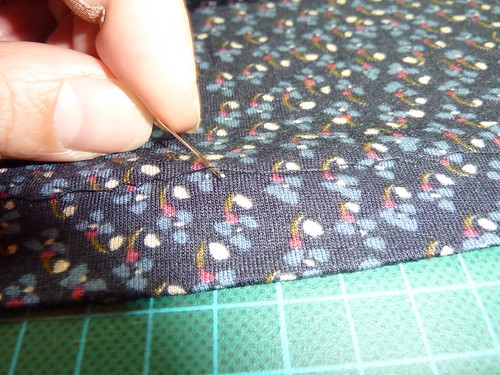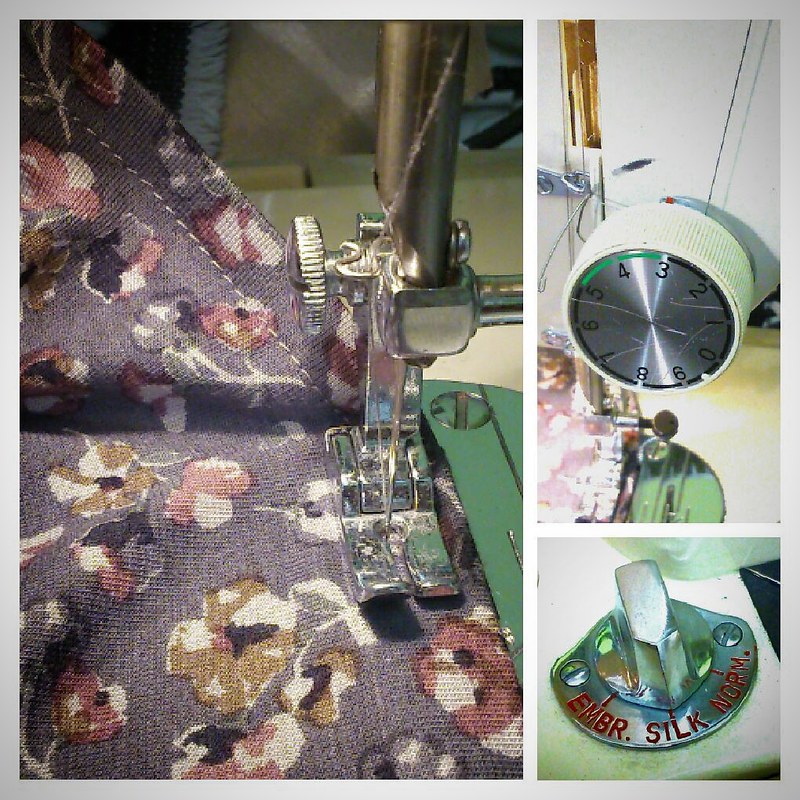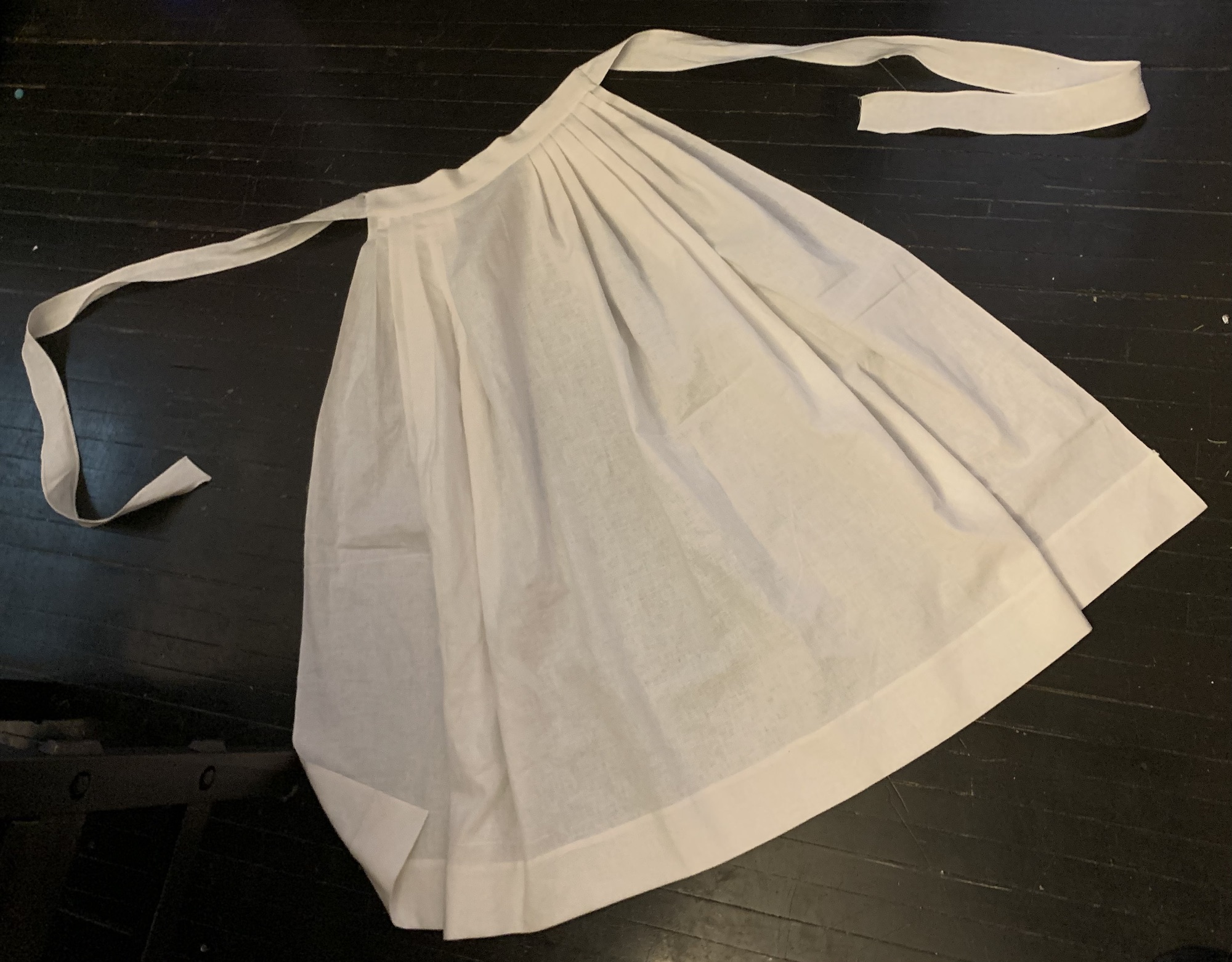These days, since the Hubster bought me my lovely Overlocker (serger) for my birthday back in 2012 I'm usually okay for 95% of construction for T-Shirts and other knit garments. I just whizz them through the 'ol Brother 1034D with a smile on my face and the wind in my hair ;-) LOL! However, in the absence of a *Coverstitch sewing machine in my life I do like to get a straight-stitch effect on my cuffs and hems using my ordinary, regular sewing machine.
See an example below, of the typical problems I used to have with skipped stitches (from way back in 2012 when I sewed up Zoe's FREE vest pattern).
 |
| Opps - can we say "Skipped stitches?" |
Previously, I struggled badly with skipped stitches and tension problems, all of which resulted in nasty, loose, unsecured, badly sewn seams, and pulled, wavy distorted hems :-(. Sooo NOT a good look for your me-made clothing!
My PREVIOUS Solution...
I had until last night, been able to alleviate some of those problems to get "nearly" okay results by:
• using a Microtex Sharp 70/10 machine needle (I had tried Universal, Ballpoint, Jersey, & Stretch needles, but counter to universally accepted advice 'Sharps' worked best for me!)
• lowering tension on my upper thread (down from my usual 5 to 4),
• using a medium stitch length (usually 2.5),
• using a narrow width zig-zag stitch (to "look like" a straight stitch),
• plus placing pieces of paper underneath the fabric (to aid it's movement through the machine - as it is sandwiched between the presser-foot from above, and by the feed-dogs beneath it).
• using a super slow speed on the foot-pedal.
NOW, What I Do Instead...
I am now able to do the following to get a straight-stitch on anything from lightweight 100% Viscose knit fabrics, to Cotton/Lycra Jerseys:
• using a Stretch 75/11 machine needle,
• lowering tension on my upper thread (down from my usual 5 to 3),
• using a longer stitch length (increasing from 2.5 to 3.5-4),
• using a straight stitch,
• plus lowering the 'Feed Dogs' to the 'Silk' setting (so the machine "grips" the fabric more gently as it passes underneath the Presser Foot during stitching).
• using a moderate-to-normal speed on the foot-pedal.
And, these new-to-me settings don't require me to carefully rip out pieces of paper, or to painstakingly use my tweezers to remove miniscule tufts from the seams ;-) And, the stitching is completed much faster too - bonus!
My Thoughts on What Went Wrong Before Previously...
I'm assuming (and this is just me theorising here) that on my old settings where the 'Feed Dogs' were on the 'Normal' setting; that perhaps the machine was gripping the fabric too tightly? Maybe, that "grip" was causing it to slightly stretch/pull and alternately sometimes allow the jersey fabrics to get stuck just a little bit. Therefore, the irregular movement of the fabric passing under the presser-foot caused missed and skipped/ill-formed stitches. With the 'Silk' setting the grip is less-firm, and I believe that the fabric now moves through evenly and smoothly - thus allowing for a good stitch-formation to occur. I also believe that the reason I previously had to use the Microtex Sharp machine needles was, because the fabric was being stretched under the too-tight grip in some instances, it was effectively overly taut (like a trampoline!) underneath the path of the descending needle. So, the rounded-tip of Ballpoint etc. style machine needles simply "bounced" off of the tight fabric surface - as it was unable to pass through the fabric easily = missed stitches!!!
*Oh, my how I DO covet a Coverstitch machine but with x2 Overlockers, x3 Novums, x2 Brothers, and a Singer hand-crank in my life already I really don't have the space for one *sigh*













.jpg)





.JPG)


















































.jpg)








Interesting theorizing and I see your point of view. Glad you found a way that worked!
ReplyDeleteThat's interesting. I've not come across machines with variable feed dogs before but it does make a lot of sense.
ReplyDeleteI will have to try your longer stitch settings! Thanks
ReplyDeleteHave you tried ye olde "Stretch and Sew" technique we used in the 70s on straight stitch machines? You stretch it as it goes under the needle so less fabric goes in each stitch and it has some give
ReplyDeleteI have a 1920s hand crank. Would stretch and stitch work as I only have one hand to stretch with...the others needed for cranking :) or do I employ my 11yo to crank for me? Never used stretch fabric before and Im a lil daunted
ReplyDeleteHi Janey, so sorry for my late reply! I would say that stretch and stitch on a hand crank would not work well for knitted fabrics. I realise that your machine is straight-stitch only, but a few of these tips here might help? SEWING KNITS - Without a Serger
DeleteAnd, also this link has some tips for straight-stitch only machines too: How to sew with knits or stretchy fabric.
Practice on lots of scraps first - you'll find results vary between different fabrics, for instance thicker (& more stable/less stretchy) Ponte Roma is easier to stitch with than lighter-weight more stretchy lycra-jerseys :-)